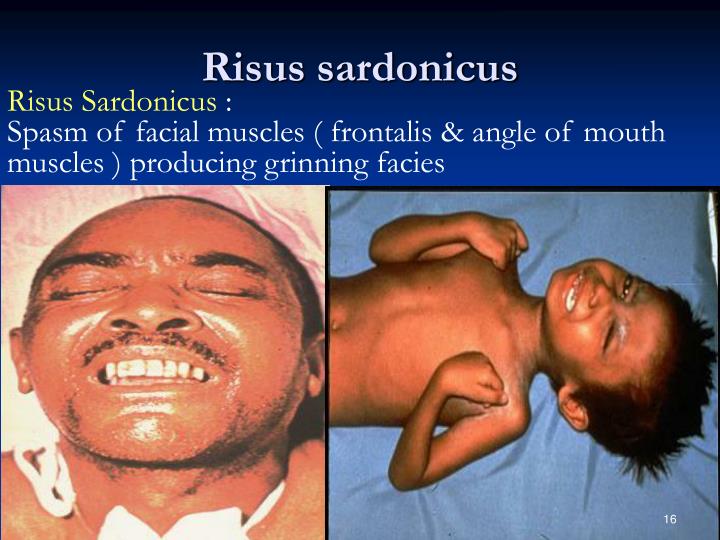
Risus sardonicus, tetanus DocCheck
noun. ri· sus sar· do· ni· cus ˈrī-səs-ˌsär-ˈdän-i-kəs ˈrē-. : a facial expression characterized by raised eyebrows and grinning distortion of the face resulting from spasm of facial muscles especially in tetanus.

PPT TETANUS PowerPoint Presentation, free download ID660894
6 Autonomic dysfunction control: magnesium sulphate as above; or morphine. Note: β-blockers such as propranolol were used in the past but can cause hypotension and sudden death; only

Risus Sardonicus r/microbiology
Selama berkontraksi, otot masseter menjadi kaku dan rahang akan tertutup rapat. Kondisi ini merupakan gejala paling awal yang jadi alarm penyakit tetanus. 2. Otot di wajah dan leher kaku. Selain otot rahang, tetanus juga diikuti gejala lain seperti kekakuan otot wajah. Kondisi ini bisa terjadi selama otot rahang kaku atau setelahnya.

'Risus Sardonicus' face. Download Scientific Diagram
risus sardonicus: [ ri´sus ] ( L. ) laughter. risus sardo´nicus a grinning expression produced by spasm of the facial muscles; seen in tetanus and certain types of poisoning.

Risus sardonicus (Medical Symptom) YouTube
Diagnosis banding tetanus merupakan penyakit dengan kondisi yang memiliki gejala serupa dengan tetanus. Tanda klinis trismus selain ditemukan pada pasien tetanus dapat pula muncul pada kasus infeksi intraoral, keracunan striknin, penggunaan obat distonik seperti metoklopramid atau fenotiazin, dan hipokalsemia. Meningoensefalitis.

Recurrent tetanus The Lancet
There are a number of medical cases in which pathological laughter has been identified as a side effect or symptom of neurological disorder; this paper considers these and other cases, where unexplained pathological laughter seems to be not a symptom of the disease, but the disease itself. Most theorists of laughter inevitably associate it with.

PPT Tetanus PowerPoint Presentation ID2171027
Tetanus is an infection characterized by a state of generalized hypertonia that manifests in the form of painful muscle spasms of the jaw and neck. The disease most commonly occurs in those who are not vaccinated or in the elderly with waning immunity. Currently, vaccination campaigns have decreased the incidence and prevalence of tetanus worldwide. The spasms from tetanus may last from.

Risus sardonicus, Tetanus, Starrkrampf DocCheck
If the address matches an existing account you will receive an email with instructions to reset your password

Risus Sardonicus Neurosigns
Risus sardonicus is a highly characteristic, abnormal, sustained spasm of the facial muscles that is most often observed as a symptom of tetanus. The name of the condition derives from the appearance of raised eyebrows and an evil, open grin that it gives to its victim. Also poisoning with strychnine may result in a risus sardonicus.

Risus sardonicus, Tetanus, Starrkrampf DocCheck
The Journal of Nervous and Mental Disease: October 2009 - Volume 197 - Issue 10 - p 790. doi: 10.1097/NMD.0b013e3181b96eb5. Free. Metrics. Risus Sardonicus. Warren M. Hern (2009) Boulder, Colorado: Alpenglo Graphics. 224 pp. $45.00. Warren Hern's title for this unique composition of poetry, photographs, and essays reflects the complexity of.

Tetanus attacks an old person with inadequate vaccination showing 'Risus Sardonicus' face
Trismus refers to the restriction of the range of motion of the jaw. Initially described in the setting of tetanus, it currently refers to restricted mouth opening due to any etiology. It is usually temporary and typically resolves in less than two weeks, but permanent trismus may also occur, interfering with everyday activities such as speaking, eating, and swallowing and complicating oral.

Tetanus a review of the literature Nursing students, Pathology, Disease
1. Introduction. The muscular rigidity and spasms of tetanus are caused by tetanus toxin (tetanospasmin), which is produced by Clostridium tetani, an anaerobic bacillus, whose spores survive in soil and cause infection by contaminating wounds [].The global incidence of tetanus has been estimated at approximately one million cases annually [1,2]..

RISUS SARDONICUS AND OPISTHOTONUS I Lockjaw Clostridium Tetani infection Abnormal Grinning
The Oxford Biblical Studies Online and Oxford Islamic Studies Online have retired. Content you previously purchased on Oxford Biblical Studies Online or Oxford Islamic Studies Online has now moved to Oxford Reference, Oxford Handbooks Online, Oxford Scholarship Online, or What Everyone Needs to Know®. For information on how to continue to view articles visit the subscriber services page.

Risus sardonicus Semantic Scholar
O Vaccine-Preventable Diseases Surveillance Standards 7 Non-neonatal Tetanus * Information on birth/termination (date, location, who attended, clean surface/hands/tools) - Parity • Application of unhygienic substances to

Risus sardonicus storia, causa e spiegazione molecolare BioPills
Key Points. Tetanus is acute poisoning resulting from a neurotoxin produced by Clostridium tetani. Symptoms are intermittent tonic spasms of voluntary muscles. Spasm of the masseters accounts for the name lockjaw. Diagnosis is clinical. Treatment is with human tetanus immune globulin and intensive support.

Risus sardonicus Semantic Scholar
Clostridium tetani (Tetanus) Itzhak Brook, in Principles and Practice of Pediatric Infectious Diseases (Sixth Edition), 2023. Generalized Tetanus. Generalized tetanus, which is a neurologic disease manifesting as trismus, risus sardonicus (sardonic smile), stiff neck, dysphagia, periods of apnea, and severe muscular spasms, is the most common manifestation of tetanus, often occurring as a.